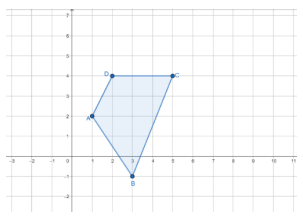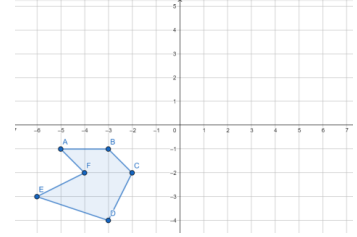Given a geometric figure and a sequence of transformations, draw the transformed figure on a coordinate plane.
: Transformations include translations, dilations, rotations and reflections described using words or using coordinates.
| Name |
Description |
| Dilation of a Line: Factor of Two | Students are asked to graph the image of three points on a line after a dilation using a center not on the line and to generalize about dilations of lines when the line does not contain the center. |
| Dilation of a Line: Factor of One Half | Students are asked to graph the image of three points on a line after a dilation using a center not on the line and to generalize about dilations of lines when the line does not contain the center. |
| Dilation of a Line Segment | Students are asked to dilate a line segment and describe the relationship between the original segment and its image. |
| Reflect a Semicircle | Students are asked to reflect a semicircle across a given line. |
| Dilation of a Line: Center on the Line | Students are asked to graph the image of two points on a line after a dilation using a center on the line and to generalize about dilations of lines when the line contains the center. |
| Rotation of a Quadrilateral | Students are asked to rotate a quadrilateral around a given point. |
| Repeated Reflections and Rotations | Students are asked to describe what happens to a triangle after repeated reflections and rotations. |
| Demonstrating Rotations | Students are asked to rotate a quadrilateral 90 degrees clockwise. |
| Demonstrating Reflections | Students are asked to reflect a quadrilateral across a given line. |
| Name |
Description |
| "Triangle Congruence Show" Starring Rigid Transformations | Students will be introduced to the definition of congruence in terms of rigid motion and use it to determine if two triangles are congruent. |
| Reflecting on the Commute | Students are given a set of coordinates that indicate a specific triangle on a coordinate plane. They will also be given a set of three reflections to move the triangle through. Students will then perform three other sequences of reflections to determine if the triangle ends up where it started. |
| Sequence of Transformations | This lesson will assist students in performing multi-step transformations. Students will follow a sequence of transformations on geometric figures using translations, reflections, and rotations. |
| Regular Polygon Transformation Investigation | This is an introductory lesson on regular polygon transformation for congruency using a hands-on approach. |
| Isometries with GeoGebra | In this lesson, students explore transformations with GeoGebra and then apply concepts using a straightedge on paper. Students apply rules for each isometry. There is a teacher-driven opening followed by individual student activity. |
| How Did It Get There? A Series of Transformation Events | Students will perform a series of transformations in order to determine how the pre-image will map onto the final image of a given figure. Students will use patty paper to manipulate their pre-image onto the image. Students will also work in collaborative groups to discuss their findings and will have the opportunity to share their series of transformations with the class. The class discussion will be used to demonstrate that there are several ways for the students to map their pre-image onto the final image. |
| Rotations of Regular Polygons | This lesson guides students through the development of a formula to find the first angle of rotation of any regular polygon to map onto itself. Free rotation simulation tools such as GeoGebra, are used. |
| Dancing For Joy | We have danced our way through reflections, rotations, and translations; now we are ready to take it up a notch by performing a sequence of transformations. Students will also discover the results when reflecting over parallel lines versus intersecting lines. |
| Product of Two Transformations | Students will identify a sequence of steps that will translate a pre-image to its image. Students will also demonstrate that the sequence of two transformations is not always commutative. |
| How to Land Your Spaceship | Teach your students to maneuver a "spaceship" through a sequence of transformations that will successfully carry it onto its landing pad. GeoGebra directons are provided. |
| Exploring Congruence Using Transformations | This is an exploratory lesson that elicits the relationship between the corresponding sides and corresponding angles of two congruent triangles. |
| How do your Air Jordans move? | In this inquiry lesson, students are moving their individually designed Air Jordans around the room to explore rigid transformations on their shoes. They will Predict-Observe-Explain the transformations and then have to explain their successes/failures to other students. |
| Triangles on a Lattice | In this activity, students will use a 3x3 square lattice to study transformations of triangles whose vertices are part of the lattice. The tasks include determining whether two triangles are congruent, which transformations connect two congruent triangles, and the number of non-congruent triangles (with vertices on the lattice) that are possible. |
| Rotations and Reflections of an Equilateral Triangle | Students will apply simple transformations (rotation and reflection) to an equilateral triangle, then determine the result of the action of two successive transformations, eventually determining whether the action satisfies the commutative and associate properties. |
| Transformations... Geometry in Motion | Students will practice and compare transformations, and then determine which have isometry. Students should have a basic understanding of the rules for each transformation as they will apply these rules in this activity. There is a teacher-led portion in this lesson followed by partner activity. Students will be asked to explain and justify their reasoning,
S |
| Reflections Hands On | Students will use a protractor/ruler to construct reflections and a composite of reflections. They will create transformations using paper cut-outs and a coordinate plane. For independent practice, students will predict and verify sequences of transformations. The teacher will need an LCD Projector and document camera. |
| Flipping Fours | Students will translate, rotate and reflect quadrilaterals (Parallelogram, Rectangle, Square, Kite, Trapezoid, and Rhombus) using a coordinate grid created on the classroom floor and on graph paper. This activity should be used following guided lessons on transformations. |
| Let's Reflect On This... | Students will use parallel and intersecting lines on the coordinate plane to transform reflections into translations and rotations. |
| Dilation Transformation | Students identify dilations, verify that polygons are similar, and use the dilation rule to map dilations. Task cards are provided for independent practice. The PowerPoint also includes detailed illustrations for constructing a dilation using a compass and a straight edge. |
| Transformers 3 | Students will learn the vocabulary of three rigid transformations, reflection, translation, and rotation, and how they relate to congruence. Students will practice transforming figures by applying each isometry and identifying which transformation was used on a figure. The teacher will assign students to take pictures of the three transformations found in the real world. |
| Transform through the Maze | In this fun activity, students will use rigid transformations to move a triangle through a maze. The activity provides applications for both honors and standard levels. It requires students to perform rotations, translations, and reflections. |
| Rotations and Reflections of an Equilateral Triangle | Students will apply simple transformations (rotation and reflection) to an equilateral triangle, then determine the result of the action of two successive transformations, eventually determining whether the action satisfies the commutative and associate properties. |



